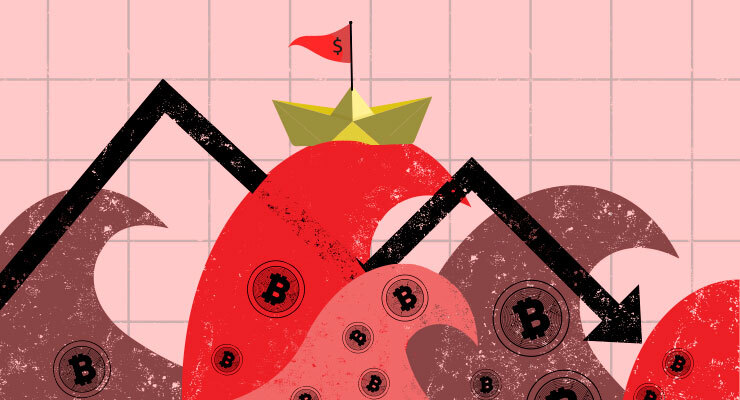
Cryptocurrency is having another meltdown moment, and the reasons why shed light on how our new environment of higher inflation and higher interest rates will change the world.
Bitcoin is down enormously, falling 26% in the last month. But the well-known cryptocurrency is a relative Rock of Gibraltar compared to many other, lesser-known coins collapsing around it. The second biggest cryptocurrency, Ethereum, is down 34% in the same period and the “joke” cryptocurrency Dogecoin is down 38%. A coin called Orion is down 85%. It’s a bloodbath.
The following chart shows changes in Bitcoin and Ethereum, measured against the US dollar, over the last year. For the final six months of 2021 they were a good bet. Recently they became a very bad bet again.

Financial markets have a saying: you find out who has been swimming naked when the tide goes out. The last decade of ever-lower inflation and ever-lower interest rates represented an historic king tide. With the water so deep and high, skinny dipping became almost compulsory.
Practices that would in historical times have counted as Ponzi schemes and frauds became widespread. They worked because they were profitable. They were profitable because money kept flowing into cryptocurrency. Money kept flowing into cryptocurrency because it was profitable.
But what happens when the tide retreats? All those people who never bothered to bring a bathing suit to the beach are exposed. Assets that make solid profits are now winners. Assets that traded on excitement, momentum, and a sense that the world had fundamentally changed? Those are now losers.
People buying NFTs (non-fungible tokens) had to believe that the world had fundamentally changed to justify spending hundreds of thousands of dollars on so-called ownership rights to simple cartoon pictures. (In a way the world had changed! Just not in a way that prevented it from changing back!) Some are now losing hundreds of thousands of dollars when they go to sell the ownership rights to those cartoon pictures.
Many cryptocurrencies offered no fundamental value other than the idea everyone believed they offered value. Admittedly, the same sort of belief is part of the reason why gold is a store of value, so we can’t be too harsh on the concept that collective delusion can be a source of value. But when it comes to collective delusions, it’s important to distinguish between those with track records and those that are faddish!
What caused the tides
The moon makes tides rise and fall in the real world. What causes our metaphorical tides that make the price of novel assets rise and fall? There is some debate on the topic but the most plausible answer is monetary policy.
Over the last decade and a half the world’s central banks have engaged in extraordinary monetary policy. They pumped liquidity into the world’s financial systems via a policy called quantitative easing, and at the same time cut interest rates to zero and below. The rise in asset-buying has been extraordinarily strong in the last two years.

When central banks buy assets, they can do so with money they just printed out of thin air. This has the effect of reducing the number of assets in circulation while increasing the amount of cash in circulation. The ratio of assets to cash falls, meaning anyone who wants an asset is competing with other people who also have lots of cash. This makes prices rise.
It also encourages people to invent new assets. It’s hard to make new land; it’s easier to make new start-up businesses and much easier to invent new cryptocurrencies and NFTs. So a lot of innovation happened in those latter areas.
It’s not just the US Federal Reserve doing this. Central banks everywhere are buying up assets and pumping out liquid cash.

At the same time, low interest rates and low inflation meant people were satisfied with assets that had payoffs far in the future. So it didn’t matter that your tech start-up was losing money in 2020, what mattered was that it could turn profitable in 2025.
Low interest rates meant you weren’t making good returns on safe investments anyway, and low inflation meant the buying power of a dollar next year would be much the same as the buying power of a dollar now, so it was a good time to invest in assets that didn’t pay off soon. Abundant liquidity and scarce good alternatives made non-profitable assets attractive.
High water marks
Now central banks are shrinking their assets bases, selling assets in exchange for liquid cash. The Reserve Bank of Australia (RBA), which increased its asset holding from 5% of GDP to nearly 30% of GDP, is now planning to decrease its holding.
Here’s how the RBA governor put it the other day: “Our balance sheet will also decline substantially in 2023 and 2024 as banks repay the funding made available under the Term Funding Facility. This contraction of our balance sheet will contribute to some tightening of financial conditions in Australia.”
That makes cash less available. And at the same time, inflation means people place a higher value on assets that are paying out right now rather than in the future. All of which causes a pivot away from speculative tech assets and bitcoin.
The downfall of Bitcoin is associated with the fall in tech stocks because both rose in this environment where people believed the world was different and were satisfied with possible payoffs in the far future. People bought stock in Netflix, for example, not for its pitiful returns in 2021 but because they believed it might one day dominate the globe’s entertainment landscape and reward them handsomely.
As the next chart shows, it’s now falling alongside Bitcoin. Its here-and-now profitability becomes more important and is found wanting. Tech stocks like Apple and Google, however, are holding up relatively well because they are established profit juggernauts.

If inflation keep rising, interest rates keep rising and central bank assets keep falling, then the future of asset markets will be in profitable companies selling things people need right now.
Crescat Capital, an investment fund that has been very contrarian for a long time, reckons this is the time to buy commodities. They predict a “major shift in market leadership from technology to natural resources-related businesses”, illustrating the opportunity with the following chart showing commodity prices are at record lows compared to the price of stocks.

They argue for investing in assets that don’t need you to believe a narrative to be impressed. Companies that sell things people need, not things they hope to onsell later. Food companies and energy companies, for example. Not cryptocurrencies, not early-stage tech start-ups, and certainly not NFTs.








I find it extraordinary that a piece supposedly explaining the recent decline in crypto assets never mentions Terra/Luna once. I don’t disagree with the general thrust of the article, but this week’s bloodbath is significantly due to the fallout of Terraform Labs trying to prop up their failed stable coin (3rd largest in the space) by selling off their BTC holdings. There’s so little real money in crypto (as opposed to the ludicrous claims about its “market cap”), that any large sell has massive price repercussions. Add to that the fact that any other DeFi project that leverages Luna is also screwed, and you’ve got a recipe for absolute carnage.
And frankly the sooner it all goes kaboom, the better for everyone, except those stupid enough to still be participating.
If you buy something, that is actually nothing, and you end up with nothing, I can’t see how you are worse off, because you still have the same nothing you initially purchased.
Crypto is as material as thoughts and prayers.
BTC and ETH forming a neat head and shoulders graph there Jason. Last night was a good time to buy. That crypto is mirroring the bourse and general economic conditions is unsurprising. Big players taking out those that overleverage by shorting is a standard tactic.
Can I buy Bitcoin with NFTs?
Which is the more valuable is the 21stC equivalent of mediaeval pinhead dancing angels debate, with even less substance than a millennia earlier.